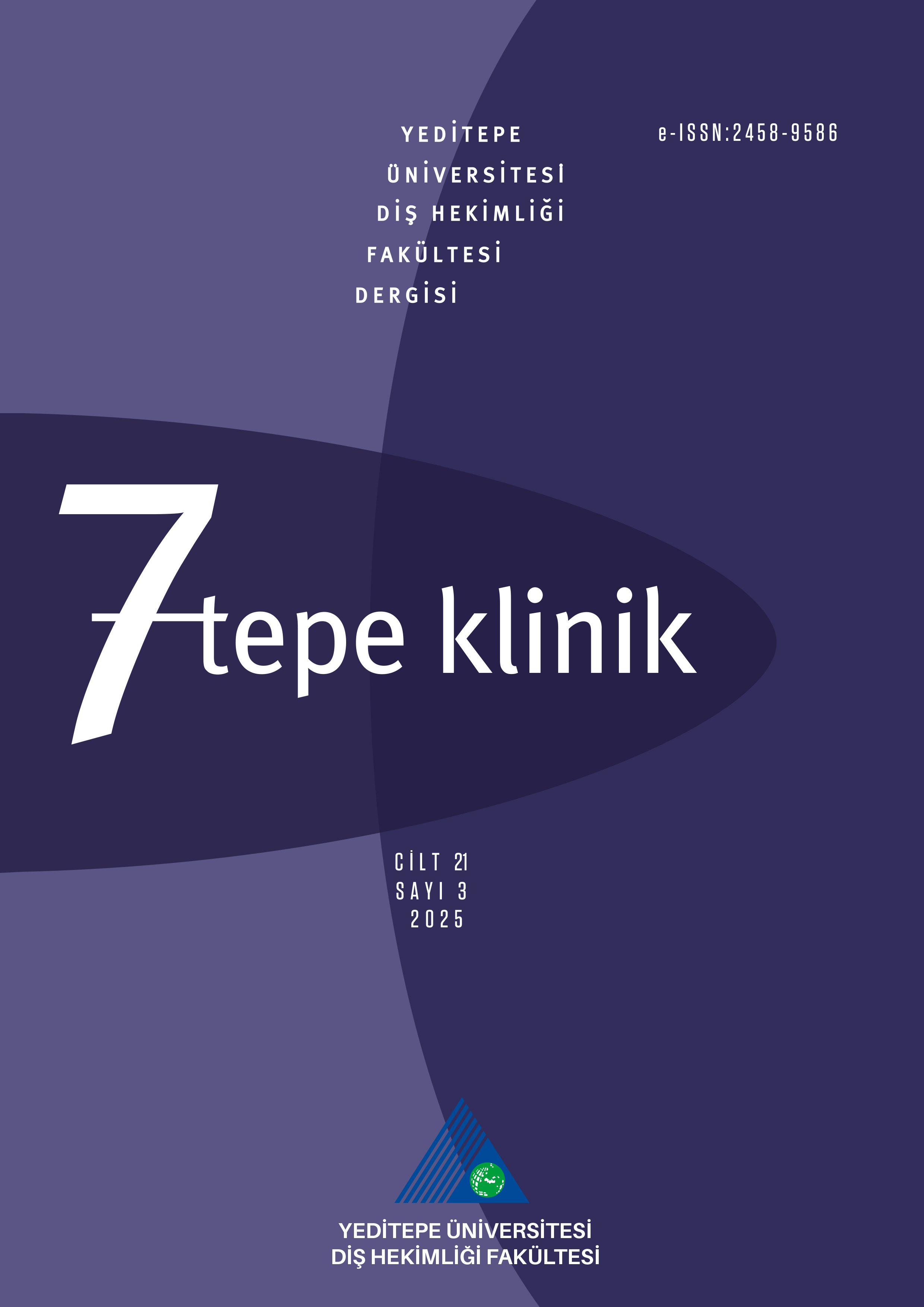Türkiyedeki ortodontistlerin klinik yaklaşımları ve tercihlerini etkileyen faktörler: Anket çalışması
Kübra Gülnur Topsakal1, Nisa Gül Amuk1, Yasemin Nur Korkmaz21Erciyes Üniversitesi Diş Hekimliği Fakültesi Ortodonti Anabilim Dalı2Abant İzzet Baysal Üniversitesi Diş Hekimliği Fakültesi Ortodonti Anabilim Dalı
GİRİŞ ve AMAÇ: Bu çalışmanın amacı, Türkiyedeki ortodontistlerin tedavi yaklaşımlarının ve aygıt/mekanik tercihlerinin belirlenmesi ve bunlar ile ortodontistlerin cinsiyetleri, meslekte geçirdikleri süre ve çalıştıkları kurum gibi faktörler arasındaki ilişkinin değerlendirilmesidir.
YÖNTEM ve GEREÇLER: Toplam 140 ortodontiste demografik bilgiler, tedavi protokolü ve tedavi mekaniği tercihleri olmak üzere 3 alt gruptan oluşan, toplam 17 soruluk bir anket e-posta ile ulaştırılmıştır. Verilerin dağılımı, yüzde ve frekanslar ile hesaplanmış, değişkenler arası ilişki Ki-kare testi kullanılarak değerlendirilmiştir.
BULGULAR: Ortodontistlerin %51,4 ile büyük bir kısmı erken dönem iskeletsel sınıf III malokluzyonun tedavisinde reverse headgear kullanmayı tercih ederken, en az tercih edilen aygıt %2,1 ile Frankel 3 aygıtıdır. Hızlı üst çene genişletmesinde %43,5 ile en fazla kullanılan aygıt bonded full akrilik RME aygıtı iken, bunu %25,7 ile banded Hyrax dizaynları takip etmektedir. Molar distalizasyonu için %37,8 ile en sık bukkal mini vida destekli distalizasyon mekanikleri tercih edilirken, pubertal büyüme atılım dönemindeki iskeletsel Sınıf II Bölüm 1 hastaların tedavisinde ise %42,8 ile en fazla oranda twin blok aygıtı kullanılmaktadır. Ortodontistlerin retansiyon protokolü tercihleri ise %39,3 ile sadece alt ve üst termoplastik ortodontik retainer (essix) olmuştur. Elde edilen sonuçlara göre ortodontistlerin çalıştıkları kurum; distalizasyon mekaniği, slot boyutu, estetik ve kapaklı braket kullanımını; meslekte geçirdikleri süre ise genişletme apareyi tercihlerini, distalizasyon mekaniği, kapaklı braket ve slot boyutu seçimlerini anlamlı biçimde etkilemektedir (p=0,000). İdeal tedavi yaklaşımının ise cinsiyet ve meslekte geçirilen süreden anlamlı şekilde etkilendiği görülmektedir (p=0,000).
TARTIŞMA ve SONUÇ: Çalışmamızın sonuçlarına göre, Türk ortodontistlerin klinik yaklaşımları koşullara göre çeşitlilik gösterir ve ortodontistlerin çalıştıkları kurum, meslekte geçirdikleri süre ve cinsiyetleritedavi yaklaşımlarında ve aygıt/mekanik tercihlerinde etkilidir.
Anahtar Kelimeler: Ortodonti, Tedavi Yaklaşımı, Aygıt Seçimi, Anket
Clinical approach of turkish orthodontists and influencing factors of preferences: Survey study
Kübra Gülnur Topsakal1, Nisa Gül Amuk1, Yasemin Nur Korkmaz21Erciyes University Faculty Of Dentistry Department Of Orthodontics2Abant İzzet Baysal University Faculty Of Dentistry Department Of Orthodontics
INTRODUCTION: The aim of this study was to determine the treatment modalities and fixed/removable appliances that Turkish orthodontists frequently preferred in their practice and to evaluate influencing factors of these preferences such asgender, professional experience and the institutionsof the orthodontists.
METHODS: A questionnaire including3 subgroups consisting of 17 questions regarding demographic information, treatment protocol preferences and treatment mechanic preferences was sent to 140 orthodontistsby e-mail. The distribution of data calculated by percentages and frequencies, Chi-Square test was used to evaluate the relationship between demographic information and preferences of orthodontists.
RESULTS: 51.4% of the orthodontists preferred to use reverse headgear for early treatment of skeletal class III malocclusion, while the least preferred device was Frankel 3 with 2.1%. The most used device was bonded full acrylic RME with 43.5% preference for rapid maxillary expansion and banded Hyrax designsfollowed it by 25.7%. Distalization was performed usually by miniscrew-assisted mechanicsby37.8% of respondents. Twin block was found to be the most popular appliance for treatment of skeletal class II division 1 patients according to 42.8% of orthodontists. 39.3% of clinicians chose orthodontic thermoplastic retainer (essix) on upper and lower jaw for retention phase. According to the results, the institution of orthodontists influencedtheir preferences regarding distalization mechanics, fixed appliance types, aesthetic bracket and self ligating bracket use significantly (p=0.001). Professional experience also affected choice of RME appliance, distalization mechanics, slot size and self ligating bracket significantly (p=0,000). Treatment approach varied by gender and professional experience of orthodontists (p=0.001).
DISCUSSION AND CONCLUSION: The clinical approaches of Turkish orthodontists change based on case and conditions.Treatment approaches and device preferencesare influenced by gender, professional experience and institutions.
Keywords: Orthodontics, Treatment Approach, Appliance Choice, Survey
Makale Dili: Türkçe



